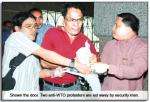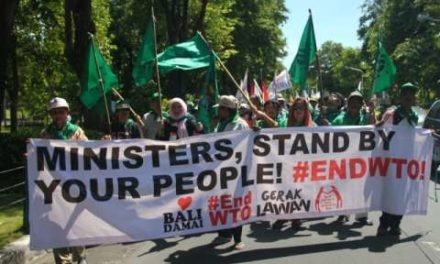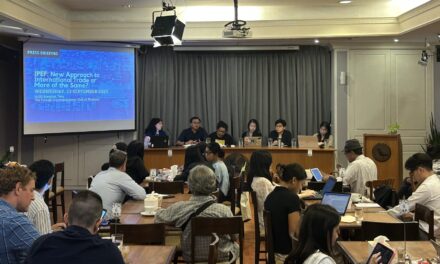Presented at the forum on Access to Justice for victims of Human Rights Abuses by Transnational Corporations organized by the Friedrich Ebert Stiftung, FDCL, and the Philippinenburo. Berlin, Germany. 27 October 2015.
By Joseph Purugganan Focus on the Global South
Let me begin by stating at the onset my main message: That human rights abuses by corporations should be situated within the context of the corporate-led development agenda that is aggressively being pursued in the Asia.
Asia has become the main driver of global economic growth. The preoccupation now in many countries in the region, and the overriding agenda is how to sustain this growth. The path to development is by and large a market-oriented, corporate driven path where the primary role of government lies in the creation of an environment that supports corporate interest, subordinating the broader public interest.
Opening up of markets, easing of regulatory regimes, privatization of public services, stricter IPR regimes, more incentives for businesses, and stronger investor protection are just some of the key elements of this strategy.
This strategy unfortunately has yielded the ugly face of corporate human rights violations.
Two cases that I want to highlight today…
Lumad Killings
The killings of indigenous peoples in Mindanao or Lumad as they are collectively called represent perhaps the current face of HR situation in the Philippines. Two recent cases:
- 8 August 2015 (Bukidnon). Five Manobo farmers, Welmer Somina, Herminio and Jobert Samia, including two children Emer Somina, 17, and Norman Samina, 14, were shot by armed men
- 1 September 2015 (Surigao del Sur) Brgy.Diatagon, Lianga, Surigao del Sur attacked by armed men. The assault of Belen Itallo and the torture and unwarranted death of Emerito Samarca, Dionel Campos, and Juvello Sinzowere directed by paramilitary forces
These two cases brought national attention to the issue of the Lumad Killings, because perhaps of the brutality of the murders, the fact that these were Lumad educators, and that the victims included teenage kids.
Unfortunately, these incidents are not isolated cases.
2012
- Ambush of Timuay Lucenio Manda of Bayog, Zamboanga del Sur, killing Jordan, 11 years old – Sept. 2012
- Capion Massacre in Kiblawan, Davao del Sur – Juvy, her children Jordan, 13, John, 8 and survived by Vicky, 4 years old – Oct. 2012 / 27th Infantry Batallion
- Sheryll Ananayo-Pugon, Kasibu, Nueva Vizcaya – witnessed by Samantha 4 years old, and John Ezekiel, 3 months old
- Kitari, relative of the Capion, shot dead, Kiblawan, January
2014
- Datu Sandigan, Higaonon of Tuburan, CDO, shot dead
- Timuay Arig, shot dead, South Upi, Maguindanao
Since 2010, more than 68 cases of extrajudicial killings of indigenous have been reported in the Philippines.
Apart from the killings however are other violations of human rights including displacement from their homes, disruption of their livelihoods, erosion of their cultures. Currently there are more than 3,000 displaced Lumads seeking refuge in evacuation centers Some have started to call these people investment refugees.
A common thread or the underlying issues around these murders are:
- Defense of their ancestral domain, and the resources therein.
- Mining, logging, plantations, dams – these are the major threats that they face.
- Rebels, sympathizers
Perhaps these maps would help us understand further the context:
These maps show the overlay of, forest areas, ancestral domain, agriculture and protected areas with mining areas of mine tenements.
The fact is that these killings, violent dispersals, and other forms of human rights violations are happening in areas where there exist serious conflicts over control of resources. These conflicts often pit large mining companies, logging concessions, mega development projects like dams against communities, often of indigenous peoples who resist the encroachment of these projects in their ancestral lands.
Another case that I want to highlight is one that is happening against fishers in Mindanao as well.
The Citra Mina case
The 43 Filipino fishermen were imprisoned in Indonesia for 6 months due to illegal fishing, sent there and neglected by the fishing company Citra Mina. Citra Mina is the second largest Tuna exporter in the Philippines, exporting to Europe, Japan, and other parts of the world. The case of abandonment has since drawn attention to the long drawn struggle of fish workers in Citra Mina over persistent violation of labor rights, including poor and dangerous working conditions, precarious employment, unjust wages.
Corporate Accountability in ASEAN
In 2012, Human Rights organization Forum Asia released a report entitled Corporate Accountability in ASEAN: A Human Rights Based Approach.
One of the things it did was to track the commitment of the 10 countries in ASEAN with respect to the key HR conventions. If we look at the Philippines, we can see that it has done not so bad, in fact pretty well within the bloc. Yet these two cases and many more continue to happen in the Philippines.
The report also identified the following problems as far as HR is concerned in the region:
- Weak human rights system: Legal and institutional deficits that fail to protect and promote HR
- State-Business Nexus: Addressing unaccountable decision-making in ASEAN
- Access to information and public participation: Addressing barriers to community, civil society and public participation
- Access to justice and redress.
The report concludes:
“Voluntary CSR initiatives promoted by business itself-and by ASEAN state institutions- are insufficient, and a move towards the principles of Corporate Accountability is urgently needed. Corporate Accountability emphasizes the need for legally binding and enforceable requirements upon businesses with regard to the protection of human rights as detailed in the core international human rights instruments, and meaningful redress where human rights violations are found to exist. In this regard, the States have an obligation to ensure a proper legal framework in line with international human rights law to regulate businesses, and to enforce these legislations effectively.”
Architecture of Impunity
The regime that exists today is really more attune to what has been called an “architecture of impunity”. The document “The Peoples Treaty on the Control of TNCs define this as an “extensive and legally binding legal framework made up of trade and investment treaties ad agreements including resolutions of international institutions like the WTO, World Bank and IMF, and investor to state dispute settlement mechanisms. This architecture confers tremendous economic, legal and political power on transnational corporations.”
This is really at the center I think of the question of access to justice and remedy; The asymmetry in law that exists where we have “hard law for corporations” and soft human rights law for the people affected by the operations of TNCs.
Corporate Rights
Just to give a sampling of what corporations have considered the injustice done to them. Corporations have sued countries over public policies on health, tobacco control, delivery of water, mining regulations, and minimum wage policies, among others.
This really underscores the need for stronger mechanisms of corporate accountability; for legally binding instruments to control the operations of TNCs that would make HR law ascendant over the corporate agenda.









